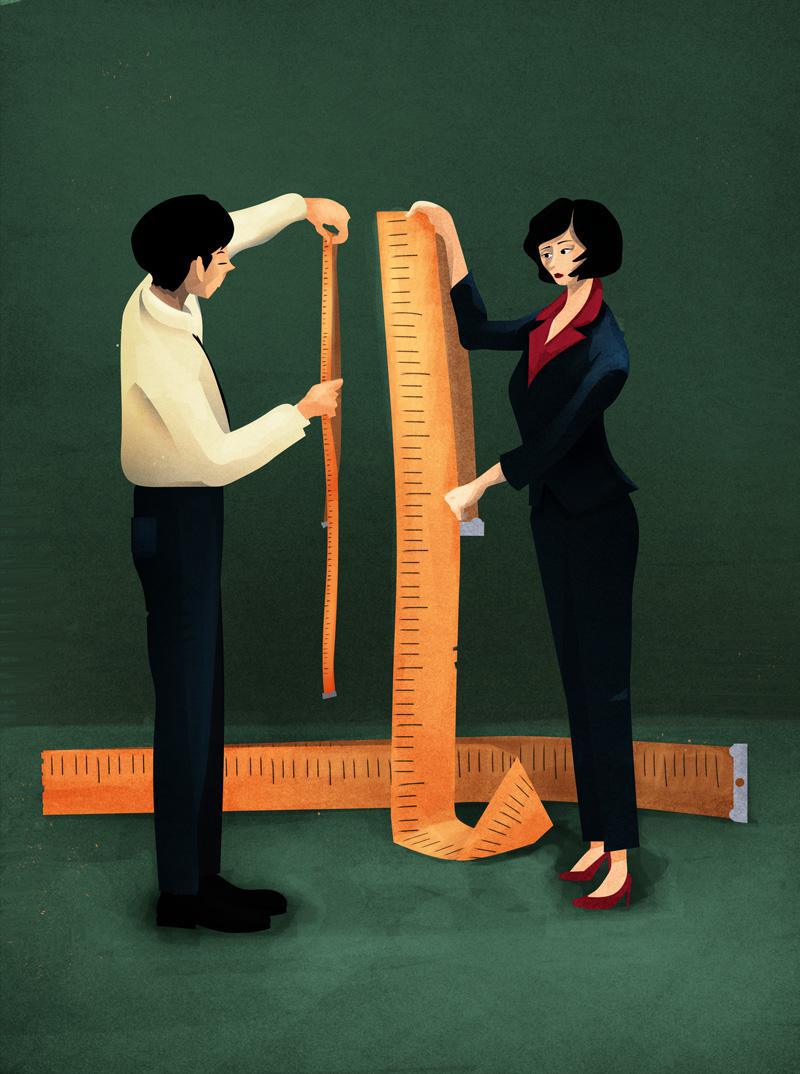Changes are taking place in the business valuations industry. A new framework has been developed by the Hong Kong Business Valuation Quality Initiative Task Force, of which the Hong Kong Institute of CPAs is a member, and aims to improve the competency and professionalism of valuers. At the same time, the International Valuation Standards Council (IVSC) has introduced a new set of standards in a bid to harmonize valuation practices worldwide.
Professionals who specialize in either the provision of valuations or the assurance of valuations play an important role in maintaining the quality of Hong Kong’s capital market.
Spencer Tse, Valuation and Advisory Service Partner at PwC Hong Kong, points out that different capital market activities, such as initial public offerings (IPOs), fundraising and venture capital or private equity investments, all involve companies being valued. “The role of a valuer is not just to give a stamp, but to provide the capital market with an objective point of view,” says Tse, who is a member of the Institute’s Financial Reporting Valuation Advisory Panel.
Institute member Wiley Pun, Director at Savills Business and Financial Instrument Valuation, agrees: “Valuation practitioners help maintain the quality of Hong Kong’s capital market by being credible and reliable, much like auditors and many other professionals.” Eugene Liu, Managing Partner and Head of Consulting, RSM Hong Kong, adds that independent professional third-party valuation reports also play a key role in giving market confidence that a transaction is fair, particularly if it involves non-cash considerations, or has a complicated target, such as a technology company, or involves patents or mining rights. “Valuation makes an observable contribution to the fairness and efficiency of the capital market,” says Liu, who is an Institute member (read more about Eugene Liu in Accountant Plus here). Rita Lau, Associate Director of Business Valuation, Valuation and Advisory Services at Colliers and an Institute member, concurs, noting that valuers also play an important role when there is a discrepancy in the expectations of price between the seller and the buyer, providing an objective valuation that serves as the guiding light for them and can help to narrow the gap.
The need for valuations
Valuers play an important role in everything from mergers and acquisitions (M&A), to financial reporting, to capital raising, to restructuring and liquidations, to tax planning.
“Valuation analysts perform valuations for numerous purposes, such as for financial reporting to fulfil the fair value measurement, asset impairment, and expected credit loss required by accounting standards like the International Financial Reporting Standards,” Liu notes. “Listing rules require valuation reports or valuations to be provided or performed for IPOs, notifiable transactions, employee share options, convertible bond issuances, and transaction pricing for disclosures and regulatory approval.”
He adds that tax authorities often require valuations for transfer pricing, gifts tax and estate tax purposes, while courts require valuations for a number of purposes, such as shareholder disputes, matrimonial disputes and estate disputes. “Sometimes, company management requires business valuations or project valuations for performance reviews or post-M&A management,” he says. Lau adds: “Management may also engage professional valuers to provide advisory work on their assets and business using financial modelling to understand how to maximize the potential of or get the best from their assets for their strategy, planning and corporate decision-making.”
Tse points out that while some valuations are carried out for internal reference, such as to be used as the basis for negotiations for potential transactions, others are for external use and the report will be seen by other parties, such as in court cases, statutory valuations for Chinese state-owned enterprises, or disclosures for public circulars and prospectuses. He adds that for external use, valuers need to be careful to state the scope of work, as while clients may understand the limitations of conducting a valuation, external parties, including the general public, may not.
Pun explains that while business valuation work may be carried out for numerous purposes, the objective is often to meet compliance and governance requirements, such as financial reporting, listing rules, internal control, or court requirements. He adds that there is a misconception that valuation is only needed for big corporations or listing rules, when it actually can be required for companies of various sizes.
A booming but fragmented industry
The professional valuations industry is currently enjoying a boom in Hong Kong. Liu explains that a combination of increasing fair value requirements in financial reporting standards, regulatory tightening and concerns about the fairness of transactions, as well as growing capital market awareness of the important role of valuations, have all driven an increase in demand for the services of professional valuers. “Many audit firms have set up an internal division for valuation audit and consulting, and many independent valuation firms have also been established in recent years to bridge the gap between booming market demand and limited supply in Hong Kong,” he says.
Lau adds that the rise in corporate transactions, such as M&As and divestments, as well as the growing importance of intellectual property to businesses, especially new economy companies, and adoption of fair value measurement in the financial reporting framework are driving demand. “The negative effects of COVID-19 on business activities and economies may result in indicators of impairment for many entities and may cause more entities to perform valuations relating to impairment testing for non-financial assets for financial reporting purposes.”
But the industry is not without its issues, and Liu points out that there are no regulatory requirements for setting up a valuation firm in Hong Kong, meaning the barrier to entry is not comparable to licensed corporations, despite the important role valuation plays in the capital markets. Pun adds: “It does not have a central regulator, and quality diverges. There are also limited avenues for complaints due to the lack of a central regulator. There is no entry barrier for anyone to claim they are a ‘qualified’ valuer.” He points out that other parties that use valuations, such as directors, auditors and financial advisors, are all subject to regulation by their respective bodies, but business valuers are largely unregulated.
Tse describes the industry as being highly fragmented. He highlights the fact that in other markets, such as the United States, companies have to follow strict guidelines in the way valuations are carried out. The situation means these companies are prepared to spend more when hiring valuers to do work for them, compared with Hong Kong, where companies may be more price sensitive. “The quality of the valuation depends on how much work the valuer does, and how many questions they ask the client about the information they need. Many firms try to do valuations in the most cost-efficient way, which makes it challenging for firms that are self-disciplined and impose a lot of policies and guidance to train people,” he explains. Tse adds that at PwC all valuations have to be approved by a senior partner before they are released to the client, while more partners are involved if the valuation is for a public disclosure for a listed company. But he points out that not all firms have the resources to conduct this type of quality control.
A competent framework
In a bid to address some of these issues, the Hong Kong Business Valuation Quality Initiative Task Force was set up, led by the IVSC, and including a number of industry bodies, such as the Institute, the Royal Institution of Chartered Surveyors, the Hong Kong Institute of Surveyors and the Chamber of Hong Kong Listed Companies. In July 2019, it published a consultation paper on a proposed framework to improve standards and professionalism in the industry, covering ethics, competency and continuing professional development, as well as setting out technical standards and a performance framework.
Tse welcomes the initiative as a “good first step,” but says: “We would like the regulators, such as the Securities and Futures Commission and Hong Kong Exchanges and Clearing, to be more active and to play a key role to push the industry to follow guidelines and be responsible for the work it does.”
Although he adds that the valuations industry is relatively new in Hong Kong, compared with other developed markets, and it will take time for it to become a more regulated environment.
Felix Wong, Principal at Ascent Partners and an Institute member, agrees that the work of the task force is helpful, but adds that there is still more to do. “Just setting up a task force is too simple. It is the next step in how the framework is launched and monitored that is important. Frequent communication with the market, and listening to and addressing the market’s needs should be considered,” he says. He suggests the task force should consider its next step, for example providing guidance on new issues such as how to value cryptocurrencies and other digital assets.
“The role of a valuer is not just to give a stamp, but to provide the capital market with an objective point of view.”
No single approach
While there is no single valuation methodology, generally accepted methodologies include an income approach, market approach and cost approach. Liu at RSM explains: “An income approach involves discounting streams of future economic benefits and costs to arrive at the present value of an asset or liability. The key factors are the reliability of the amount and timing of the economic benefits and costs, and the appropriate estimation of the discount rate. “A market approach involves benchmarking against comparable transactions or comparable companies and is based on valuation multiples, such as price-to-sales, price-to-earning, and price-to-books ratios for valuing the subject item.”
He points out that when using this method, the screening and selection of comparable transactions is crucial, while a detailed understanding of the subject and comparable companies is also important. “A cost approach is based on the concept that a buyer will pay no more for an asset than the cost to obtain an asset of equal utility, whether by purchase or by construction, unless undue time, inconvenience, risk or other factors are involved. It provides an indication of value by calculating the current replacement or reproduction cost of an asset and making deductions for physical deterioration and all other forms of obsolescence,” he explains.
Pun at Savills adds that within these approaches, there are a range of other sub-methods that are used. “These are mainly the discounted cash flow method, guideline public company method, guideline transaction method and summation method,” he says. Wong points out that different methodologies will be appropriate in different circumstances to establish the fair value of an asset. But he adds that traditional methodologies are often difficult to apply to new economy companies that may not be generating a revenue yet. “In these cases, we discount by the risk associated with the company and reference other deals in the market. Valuers need a lot of market knowledge and access to services such as Bloomberg and listed company announcements. They need to be very commercialized to know what has happened out there,” he says. Lau at Colliers points out that as no one method is suitable in all circumstances, valuers need to consider the terms and purpose of the valuation, the strengths and weaknesses of the different approaches, their appropriateness in terms of the nature of the asset, and the availability of reliable information that is needed to apply the various methods when deciding which one to use.
While there is no single set of valuation standards that is recognized worldwide, the latest edition of the International Valuation Standards (IVS) marks an important step towards harmonizing valuation practice worldwide. The set of standards includes five general standards, which apply to all valuations, and six asset-specific standards covering areas such as intangible assets, businesses and business interests, plant and equipment, and financial instruments. Lau considers it to be a significant milestone. “IVS are universally accepted standards for the valuation of assets, including business and intangible assets, across the world in the public interest. The latest edition brings greater depth to the IVS, as recommended by member organizations, including the major accounting firms and valuation professional organizations. It will serve as the key guide for valuation professionals globally,” she says. Tse at PwC adds: “The efforts of the board of IVSC have been well recognized and now more and more countries recognize the IVS. The adoption of IVS is still uncommon in Hong Kong, but I do see some valuers refer to the basis of value per IVS for particular engagements. It is a step in the right direction, but it will take time before it is comparable to accounting standards and there is a globally accepted standard worldwide.”
“The latest edition brings greater depth to the IVS, as recommended by member organizations, including the major accounting firms and valuation professional organizations.”
A range of challenges
Professional valuers face a number of challenges in their day-to-day work, ranging from keeping up to date with best practices to the increasing need to value new economy companies. Liu points out that as a lot of fair value measurements evolved from financial reporting standards, and as a result, in addition to their day jobs, valuers also need to attend seminars, workshops and forums after office hours to keep up to date with those standards, as well as of what is happening in the wider market.
Valuation professionals also need to make assumptions behind the figures they use in calculations. “We need to make sure they are reasonable so as to make the output reasonable, meaningful and useful. For us to be able to assess the reasonableness of the assumptions and inputs, we are required to be familiar with not only the relevant accounting and financial knowledge, but also some industry knowledge, such as the value of a patent, or a new drug,” Liu explains.
Another challenge is the need to value intangible assets and new economy companies.
Wong thinks the main challenge in valuing intangible assets relates to the transparency of the data and information that is available on them. He adds that valuing new economy companies, such as biotech firms or other technology companies that are pre-revenue generating can also be difficult, as valuers have to look at company’s technology and how much revenue it could generate in future, as well as referencing market transactions of similar companies. “A lot of start-ups can be overpriced and investors still need a guideline,” he says.
Tse says one of the biggest challenges involved in valuing new economy companies is understanding their business model and how they will make money in the future. He explains that valuers have to consider factors such as the company’s potential future market share and the competition it will face, as this will affect the sustainability of its growth and profitability. “We don’t have a historical track record as these may be start-ups, so deciding whether their performance can be sustained in the longer term is a challenge,” he says. Tse adds that in order to overcome these issues, valuers tend not to rely on just one valuation method, but rather use different methods and different scenarios to test which factors are most important in terms of their impact on the company. He points out that while for traditional companies, practitioners will normally come up with a valuation range of 10 percent to 30 percent, while for new economy ones, the range is typically wider at 40 percent to 50 percent.
For Pun, the biggest challenge business valuers face is uncertainty. “Business valuations often make use of financial projections, especially those using an income approach and sometimes a market approach. How to factor in the uncertainty embedded in these financial projections is the most difficult part of our work,” he says. He adds that another significant challenge is benchmarking when using the market approach. Pun explains: “Even if good, comparable public companies exist, they often have some differences from the subject company being valued. Assessing and explaining the differences in valuation levels among the companies requires lots of analysis and judgement.”
Wong agrees, pointing out that each transaction is different. “For certain types of assets, such as bonds or listed stocks or instruments issued by banks, valuations can be done in a straightforward way using a standardized methodology, but valuations can be complicated for other assets. The valuation of a bank will be very different to the valuation of a pharmaceutical company, for example,” he says. “With a bank you would look at cash flow, financial information, whereas with a pharmaceutical company you would look at the potential drugs or other research and development in the pipeline with respect to the forecasted timeline to launch. You cannot just use a straightforward international standard; you need to go into the details of each company, such as its management, its revenue stream, how diversified it is, whether it is the market leader, and the downside risks it faces.”
He adds that while the IVS guidelines issued by the IVSC give valuers rules to consider in general, they cannot always be adopted, and some judgement is still necessary. Wong points out that the COVID-19 pandemic had also affected the approach professionals need to take when valuing certain businesses. He gives the example of the impact successfully developing an effective COVID-19 vaccine can have on the valuation of a pharmaceutical company. Lau agrees that the pandemic has created new challenges. “During COVID-19, companies in the same industries may be impacted differently because of decisions made by their management. When performing a business valuation, it is crucial for professional valuers to understand the management’s strategy and business plan, the industry development in which the subject company has business operations and the financial performance of comparable companies,” she says.
Maintaining scepticism
Unsurprisingly, given the varied nature of their work, valuation practitioners need a wide variety of skills and attributes. Pun points out that valuers need to be strong in numbers, interested in business and valuations in general, and have good communication skills. He adds that valuations professionals also need to keep up with new trends, such as the emergence of new economy businesses, or the impact environmental, social and governance factors can have on valuations, as well as maintaining a good awareness of the interaction between the micro and macro economy. Strong ethical standards are also important. Pun explains: “Similar to auditors who are often pushed by clients to issue a clean audit opinion, valuers often face pressure from clients to reach a certain level of value.” Finally, he suggests valuers should be curious, have professional scepticism and be good multitaskers.
Wong at Ascent Partners agrees that accountants have the skills and personality attributes needed to be successful valuation professionals. “On the technical side, they need to be good at doing research and crunching numbers, and they must be very detail-orientated and have a high level of technical knowledge. “They also need good social skills to be able to communicate with clients. A lot of transactions require discussions with clients, such as on the background to the transaction and what they hope to achieve,” he says. Wong adds that valuers must also be good at working under pressure, as sometimes clients require valuations to be turned around quickly, often in as little as 10 days in the case of M&As. Finally, he points out that for some transactions, the client may not be able to supply the valuer with all of the information they require, so the valuer must be able to find what they need themselves. “You must be versatile to come up with more information and find the optimum approach to valuing a particular transaction,” Wong says.
Tse says: “While some people will say valuation is an art rather than a science, to do a proper valuation, valuation practitioners need to have financial and accounting knowledge, a fair understanding of the business being valued, a little bit of tax knowledge, some modelling skills, and some understanding of valuation techniques for different types of assets. “They must be open minded, interested in continuous learning, have an analytical mindset and good communication skills. They should also be interested in understanding the investment world and capital markets.”
On top of the technical skills they require, Liu says valuation practitioners need to maintain a cautious and sceptical mind throughout. “You always need to be cautious in terms of the accuracy of the inputs you are using and the appropriateness of the valuation methodology you are adopting. In addition, you need to have a sceptical mind about the financial forecasts and operating performance of a business that the business owner or manager might give you.”
For CPAs interested in becoming a valuer, particularly those who currently work in audit, Lau says: “More and more employers consider candidates with auditing experience that can help them to communicate with the client’s audit team more effectively. The knowledge and experience gained from auditing can be an invaluable asset, however, they should open their mind to new ideas.” She adds that with the valuation of financial instruments becoming more common, they should also be prepared to study finance, even becoming a Chartered Financial Analyst, to improve their career prospects, particularly if they are considering moving to a private equity firm in the future.
Wong adds that a sound accounting and financial knowledge will also enable valuers to read and understand financial statements. As a career, Tse thinks the continued growth of the financial and capital markets in Hong Kong, along with the development of the Greater Bay Area provides great opportunities for valuations professionals.
Lau adds that people interested in becoming valuers should also familiarize themselves with some of the tools used. “During the valuation process, we will collect market and financial data depending on the nature of the valuation subject from data providers such as Bloomberg, Capital IQ or Thomson Reuters Refinitiv Eikon for analysis, which is the key part of the valuation workflow. New joiners can learn more about different platforms and terminals through on-the-job training or training courses provided by representatives of data providers. Since it is common for us to analyse data in Excel with Excel formulas and tools and to build complex financial models, proficiency in Excel will greatly speed up the workflow.”
“Valuation practitioners need to have financial and accounting knowledge, a fair understanding of the business being valued, a little bit of tax knowledge, some modelling skills, and some understanding of valuation techniques for different types of assets.”
A day in the life of a valuation professional
Valuation professionals have busy but varied days. Unsurprisingly, the typical day of a valuer differs significantly according to their role. Spencer Tse, Valuation and Advisory Service Partner at PwC Hong Kong, points out that an analyst will typically spend their day doing research, financial analysis and financial modelling, while a manager will be engaged with project planning, meeting and calling clients, reviewing work done by analysts and writing reports. Directors and partners are more involved in business development, as well as coaching their team and reviewing the work done by subordinates. Tse says: “I do a lot of marketing and meeting with clients, particularly those in acquisition mode. The role of a valuer is now transforming from being a pure valuer to a deal advisor.”
Like auditors, the work of valuation professionals has a peak season, typically from January to March, and from July to August. Rita Lau, Associate Director of Business Valuation, Valuation and Advisory Services at Colliers, says: “The schedule is packed every working day during the peak seasons when the team is working hard to meet the agreed deadline for business valuations used for listed companies’ financial reporting purposes.” Lau typically begins her day by reviewing her emails and checking her meeting schedule. Next, she has discussions with her team about the status of their various engagements, as well as any market updates or valuation issues, before preparing material for meetings with different clients. Most of her day is taken up with meetings. At the end of the day, she holds another discussion with her team to review their work. She pays particular attention to their replies to questions raised by second valuers, who are engaged by clients’ audit teams for financial reporting purposes. “If the business valuation is used for a public transaction, there are frequent conference calls with other professional parties, including auditors, lawyers, financial advisors, and the management team, so that we can work closely to meet the tight schedule,” she says.
Wiley Pun, Director at Savills Business and Financial Instrument Valuation, also starts his day by checking to see if there are any updates from clients and colleagues on existing projects and ensuring that engagements are progressing well. He then typically reviews the work and reports of his colleagues, and holds discussions with clients, auditors and their specialist review teams for more complicated projects. “As valuation is a highly judgemental subject, we keep the dialogue open to exchange our views to ensure consistent understanding between all three parties,” he says. When a new project comes in, he reviews the valuation subject and identifies the key areas of risk, as well as commenting on the scope of the engagement and the fee. Pun also makes time to read business news, as well as various valuation and accounting newsletters he subscribes to, ensuring he remains up to date with market developments. “Since we cover a wide spectrum of industries and given the interconnectedness of the economy nowadays, we need to read broadly to ensure our valuation opinion remains relevant in today’s fast changing world, and to spot business opportunities,” he says.
Institute offers new course on valuations
This year, the Institute is offering a brand new course on valuations, the Business Valuation Programme, in collaboration with Savills Valuation and Professional Services (S) Pte Ltd., a global real estate services provider actively involved in setting valuation standards. The programme will guide participants through performing valuations, including the relevant International Valuation Standards and their interactions with financial reporting standards.
The programme includes a mix of live and e-learning sessions. There are 11 compulsory modules covering the fundamentals of valuations, valuing transactions, financial reporting valuations, and the application of valuations. There are also four elective modules covering valuing financial instruments, property, plant and equipment, and biological assets. Participants are required to take two elective modules as part of the programme.
The pilot intake of the programme will be held in April to June 2021, and will then be run twice-yearly. For the pilot, all live modules will be conducted via Zoom. Look out for more details on the programme on the Institute’s website and CPD Highlights weekly email.





















